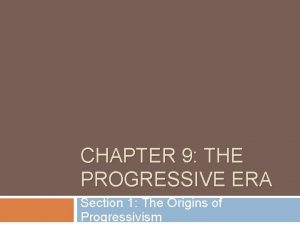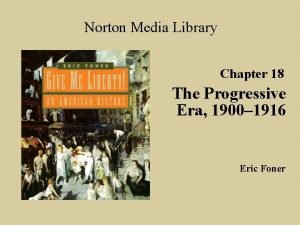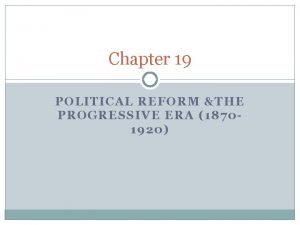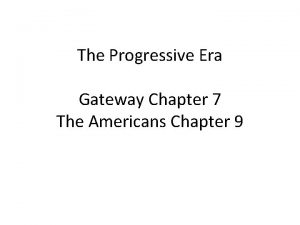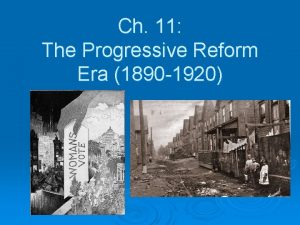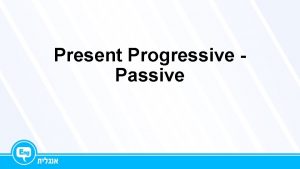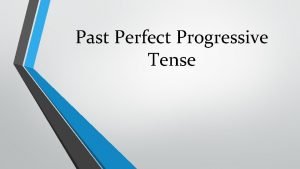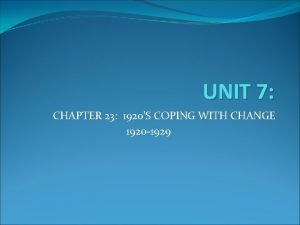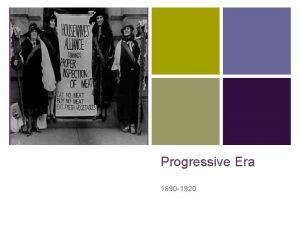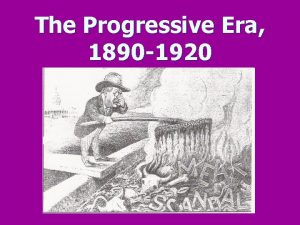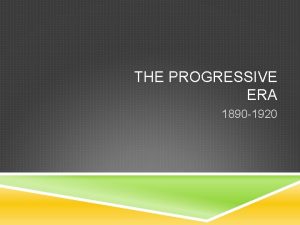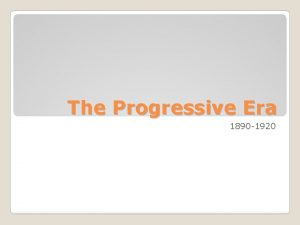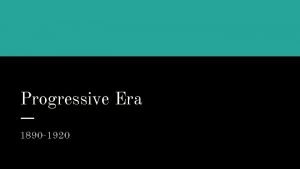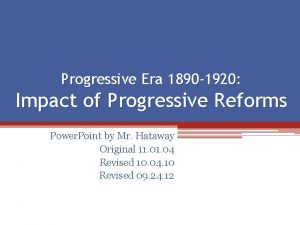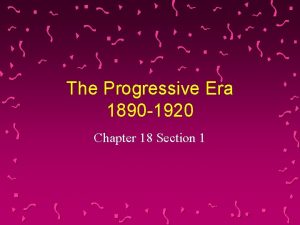THE PROGRESSIVE ERA 1890 1920 Chapter 6 Section









- Slides: 9

THE PROGRESSIVE ERA 1890 -1920 Chapter 6

Section 1 – The Drive For Reform Section Objectives � 1) Identify the origins of Progressivism � 2) Analyze the role that journalists played in the Progressive Movement � 3) Evaluate some of the social reforms that Progressives tackled � 4) Identify the political changes brought about by the Progressive movement

Origins of Progressivism Beliefs of Progressives � Progressivism A movement that started in � the 1890 s, promoting new ideas and honest and � efficient government to Industrialization & urbanization had caused social & political problems during the GILDED AGE Highly educated leaders should use modern ideas & scientific techniques to improve society 4 Goals of Progressivism: bring about social justice � 1) protecting social welfare 2) promoting moral improvement 3) creating economic reform 4) fostering efficiency Progressive Targets: Trusts – big business control Political Machines – political corruption Poverty gap – gap between the rich & poor (poor working conditions/child labor/poor urban conditions)

Muckrakers Reveal the Need for Reform Muckrakers � Writer **Teddy Roosevelt nicknamed these writers “Muck Rakers” because of what he perceived as their obsession with scandal and corruption who uncovers & exposes misconduct in business or politics (Name given by Pres. Theodore Roosevelt) � Socially conscious journalists/writers dramatically exposed the need for reform in different ways Popular Muckrakers � Lincoln Steffens – The Shame of the Cities � Jacob Riis – How the Other Half Lives � Upton Sinclair – The Jungle

Reforming Government *Some progressives believed that government was corrupt, and the application of efficient business methods would best solve problems of government. Scientific Management – a scientific approach to business (managing time, breaking down tasks, and using standardized tools) that could be used to make government more efficient and honest. 2 Progressive Models of Local Government: � 1) Commission Plan � City government divided into different departments Each department under an expert commissioner’s control 2) Council – Manager System A city manager was hired by the city council to run the operations of the city government more efficiently *Both models were a response to Gilded Age cronyism and patronage that led to corruption and inefficiency in government.

Reforming Government Some Progressives believed government would be more honest if it were more DEMOCRATIC. How to make elected officials more accountable to voters? Direct Primary: Election in which citizens themselves vote to select nominees for upcoming elections. � Initiative: Process in which citizens put a proposed new law directly on the ballot � � Governor Robert M. La Follette (Wisconsin) Petition Did not have to wait for elected officials to act. Referendum: Allowed citizens to approve or reject laws passed by legislatures. Recall: Gave voters the power to remove public officials from office before their terms ended. 17 th Amendment: Direct election of senators by voters, not state legislators. SECTION FOCUS: How did each of these political reforms help slow down political corruption?

Reformers Champion Working Women’s Rights Wanted to improve MORALS in society Florence Kelley � National Consumers League (NCL) - Labels to inform consumers to buy “safely made” products Inspect meatpacking plants Make workplaces safer Make payments to the unemployed � Women’s Temperance = not drinking alcohol Minimum Trade Union League wage/8 hour workday/workers’ strike fund

Women Fight for the Right to Vote National American Woman Suffrage Association (NAWSA) � President: Carrie Chapman Catt � 1 st Front: Constitutional Amendment � 2 nd Front: Referendum to pass new state suffrage laws � “Society Plan”: To recruit wealthy, well educated women. “Suffragettes” Suffrage = the right to vote 19 th Amendment: June, 1919 (“the right to vote shall not be denied or abridged on account of sex”) � Women gained right to vote b/c of help during WW 1 � TN was 36 th state to ratify the 19 th Amendment (final vote needed)

Progressives Reform Society *Many progressives focused on social problems such as crime, illiteracy, alcohol abuse, child labor, and the health and safety of Americans. Child Labor � � Florence Kelley helped form the National Child Labor Committee, which successfully lobbied the federal government to create the U. S. Children’s Bureau. Keating-Owens Act: (1916) Banned child labor. Supreme Court Ruled Unconstitutional 2 years later 1938 Child Labor was Banned Industrial Workers � � New York passed laws to make workplaces safer, and other cities and states followed suit. (1911 Triangle Shirtwaist Factory Fire: 146 dead) Workers Compensation 10 Hour Work Days Lochner v. New York: Ruled some laws unconstitutional, claiming that the state did not have the right to interfere with liberty of
 Chapter 9 the progressive era section 1 answers
Chapter 9 the progressive era section 1 answers Give me liberty chapter 18
Give me liberty chapter 18 Chapter 19 political reform and the progressive era
Chapter 19 political reform and the progressive era Gateway to us history chapter 7 the progressive era
Gateway to us history chapter 7 the progressive era Chapter 11 the progressive reform era
Chapter 11 the progressive reform era Progressive passive
Progressive passive Simple past and past progressive
Simple past and past progressive Present continuous tense function
Present continuous tense function Calvin coolidge
Calvin coolidge Old imperialism vs new imperialism
Old imperialism vs new imperialism
